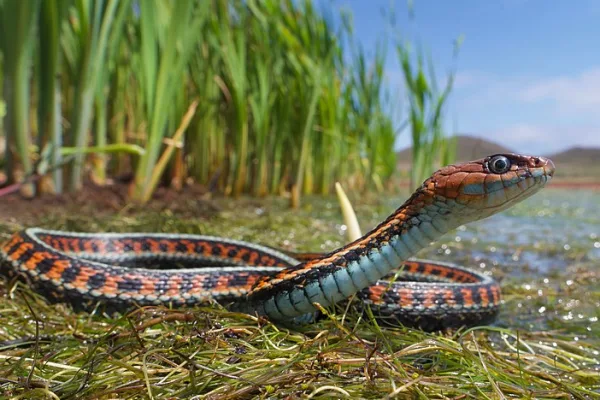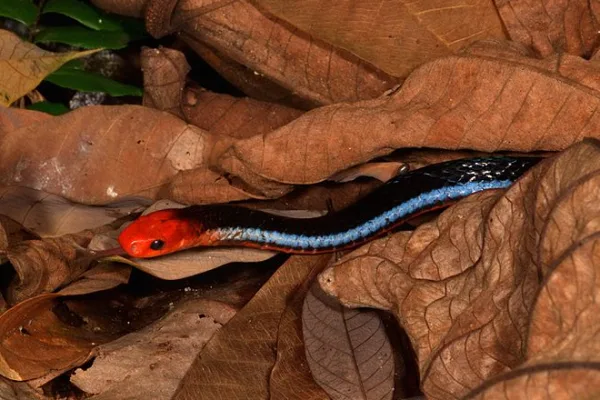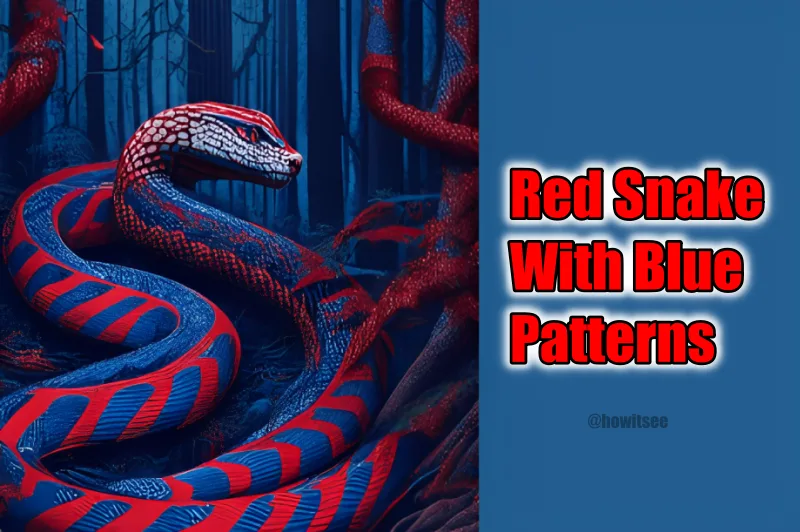Snakes have captivated the human imagination for centuries with their sleek bodies, mesmerizing patterns, and mysterious behaviors. With their incredible adaptations and unique characteristics, they have thrived in almost every corner of the Earth.
From the mighty pythons that can grow to astonishing lengths, to the venomous cobras that command our respect and awe, snakes come in a wide array of shapes, sizes, and colors. Among them, those adorned with shades of red and blue are among the most fascinating and eye-catching.
In this article Red Snake with Blue Patterns, we will embark on a journey to discover these captivating serpents that display vibrant tones of red and blue in their scales.
Spotting a snake is quite common, and when you spot a snake its identification becomes quite important, to know if it’s venomous or not, so that preventive measures can be taken accordingly. For this very reason, we bring to you our today’s article, Red Snake with Blue Patterns– What Could it Be?
Red Snake with Blue Patterns– What Could it Be?
Red Snakes with Blue Patterns are quite rare, and only a handful of them possess this captivating combination, with muted colors like black and shades of brown being the most widespread.
Bright colors like red and blue often serve as a warning to potential predators. Their bright coloration is an example of aposematism, a strategy used by many venomous animals to signal their toxicity and deter predators.
In America, several species of snakes inhabit various environments. Red Snake with Blue Patterns like the California Red Sided Garter Snake, the Blue Malayan Coral Snake, and the Red Headed Krait, etc. are all essential components of the planet’s biodiversity and each contributes to the ecosystem in its way.
Later, in this article, we are going to talk about each species and its unique characteristics in detail.
Red Snake with Blue Patterns
1. California Red-Sided Garter Snake

| Scientific Name | Thamnophis sirtalis infernalis |
| Size | 2-3.5 feet |
| Habitat | Wetland areas |
| Location | Coastal California |
As its name suggests, the California Red-Sided Garter Snake boasts a distinctive red coloration on its head and sides, accentuated by bold black vertical stripes. There is a long blue dorsal stripe that runs along the full length of its body, along with a similar stripe on either side.
Those with a blue stripe also display a bluish underside, especially below the head and in the tail region. Like other garter snake species, it has a slender body and is known for its agility both on land and in water.
The venom of California Red-sided Garter Snakes, though enough to kill their prey, lacks their potency in humans. Since these snakes inhabit marshy wetland areas, they will often swiftly escape into the waters if it perceives any threat.
2. Blue Malayan Coral Snake

| Scientific Name | Calliophis bivirgata |
| Size | 80 centimeters |
| Habitat | Tropical forests among leaf litters |
| Location | Indonesia, Brunei, Malaysia, Thailand, etc. |
The next snake species in this list of Red Snake, with Blue Patterns is the Blue Malayan Coral Snake. One of the most distinctive features of the Malayan Coral Snake is its vibrant and eye-catching coloration.
The snake’s body is adorned with a vivid red color head, with dark blue to blackish back and a characteristic long blue stripe on each side of the body. Despite its small size, this snake possesses potent venom, which distinguishes it from its similar-looking counterpart, the Pink Headed Reed Snake.
The venom has cytotoxins and calliotoxins which block the sodium channels of the victim, causing instant paralysis.
3. San Francisco Garter Snake
| Scientific Name | Thamnophis sirtalis tetrataenia |
| Size | 1.2 meters |
| Habitat | aquatic and upland habitat |
| Location | San Mateo County Coast |
The San Francisco Garter Snake is undoubtedly one of the most beautiful snakes, not only in North America but also in the world. Its vibrant color patterns, which consist of three primary colors: red, black, and blue.
The snake’s body is adorned with bold redhead, a wide blue dorsal strip that runs down its entire length, alternating black and red stripes, and a bluish underside. The San Francisco Garter Snake, unlike venomous snakes, does not possess any venom.
Instead, it relies on its agility, speed, and camouflage to avoid predation. Unfortunately, the San Francisco Garter Snake is listed as endangered due to habitat loss, fragmentation, and the introduction of non-native species.
Wetland drainage, urban development, and agricultural practices have significantly impacted its natural habitat.
4. Red Headed Krait

| Scientific Name | Bungarus flaviceps |
| Size | 1.2-1.5 meters |
| Habitat | Mountainous forests |
| Location | Malaysia, Thailand, Singapore, etc. |
As the name suggests, Red Headed Kraits have a vibrant red color head and tail, and a black body that bears a narrow lateral bluish stripe. The Red Headed Krait is a member of the Elapidae family, which includes other venomous snakes such as cobras and coral snakes.
The venom of the Red Headed Krait contains potent neurotoxins that can be lethal to its prey and potentially dangerous to humans. These neurotoxins interfere with nerve signals, leading to paralysis and potentially respiratory failure.
Bites from this snake can be life-threatening, and immediate medical attention is essential. Despite its venomous nature, the Red Headed Krait is generally non-aggressive and prefers to avoid confrontation.
It relies on its cryptic coloration and nocturnal habits to stay hidden from potential threats. However, when provoked or threatened, it may bite as a defense mechanism.
5. Mexican Redtail Indigo Snake
| Scientific Name | Drymarchon corais erebennus |
| Size | 2.4 meters |
| Habitat | Forest areas, grasslands, agricultural lands |
| Location | Mexico and certain parts of Central America |
With a reddish brown underside and bluish-black dorsal side, the Mexican Redtail Indigo Snake is the last member of this list of Red Snake with Blue Patterns. Mexican redtails exhibit a fantastic display of red and bluish-black, especially on their lateral sides, which are red with intervening blue streaks.
Quite like Boas and Pythons, the Mexica Redtail Indigo Snake is also a constrictor. This snake does not possess venom glands or produce venom. Using its sharp teeth, it bites and constricts its prey, squeezing it tightly until it succumbs to suffocation.
Here, we come to the end of this article, Red Snake with Blue Patterns. So next time you see a Red and Blue snake, you know exactly where to come to. We will be back soon, with many more interesting topics. So stay tuned until then.
References:
- U.S. Fish and Wildlife Service- San Francisco Garter Snake
- Snake facts Weebly.com- California Red Sided Garter Snake
Also Read:

A zoology student turned writer. Nature has always been a magnet to me, and to unearth some of its secrets through my articles is my prime intention. If not engaging myself with nature and anime content, you can always find me going through some Bengali classics or filling the air with some soulful Tabla beats. An artist, trying to throw some colors to my blank canvas of life.
